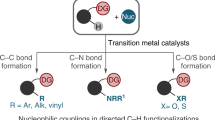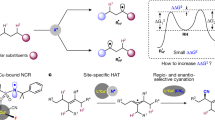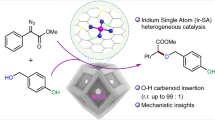Abstract
In chemical syntheses, the activation of carbon–hydrogen (C–H) bonds converts them directly into carbon–carbon or carbon–heteroatom bonds without requiring any prior functionalization. C–H activation can thus substantially reduce the number of steps involved in a synthesis. A single specific C–H bond in a substrate can be activated by using a ‘directing’ (usually a functional) group to obtain the desired product selectively1,2,3,4,5. The applicability of such a C–H activation reaction can be severely curtailed by the distance of the C–H bond in question from the directing group, and by the shape of the substrate, but several approaches have been developed to overcome these limitations6,7,8,9,10,11,12. In one such approach, an understanding of the distal and geometric relationships between the functional groups and C–H bonds of a substrate has been exploited to achieve meta-selective C–H activation by using a covalently attached, U-shaped template13,14,15,16,17. However, stoichiometric installation of this template has not been feasible in the absence of an appropriate functional group on which to attach it. Here we report the design of a catalytic, bifunctional nitrile template that binds a heterocyclic substrate via a reversible coordination instead of a covalent linkage. The two metal centres coordinated to this template have different roles: one reversibly anchors substrates near the catalyst, and the other cleaves remote C–H bonds. Using this strategy, we demonstrate remote, site-selective C–H olefination of heterocyclic substrates that do not have the necessary functional groups for covalently attaching templates.
This is a preview of subscription content, access via your institution
Access options
Access Nature and 54 other Nature Portfolio journals
Get Nature+, our best-value online-access subscription
$29.99 / 30 days
cancel any time
Subscribe to this journal
Receive 51 print issues and online access
$199.00 per year
only $3.90 per issue
Buy this article
- Purchase on Springer Link
- Instant access to full article PDF
Prices may be subject to local taxes which are calculated during checkout




Similar content being viewed by others
References
Snieckus, V. Directed ortho metalation. Tertiary amide and O-carbamate directors in synthetic strategies for polysubstituted aromatics. Chem. Revc. 90, 879–933 (1990)
Flemming, J. P., Berry, M. B. & Brown, J. M. Sequential ortho-lithiations; the sulfoxide group as a relay to enable meta-substitution. Org. Biomol. Chem. 6, 1215–1221 (2008)
Daugulis, O., Do, H.-Q. & Shabashov, D. Palladium- and copper-catalyzed arylation of carbon-hydrogen bonds. Acc. Chem. Res. 42, 1074–1086 (2009)
Lyons, T. W. & Sanford, M. S. Palladium-catalyzed ligand-directed C-H functionalization reactions. Chem. Rev. 110, 1147–1169 (2010)
Colby, D. A., Bergman, R. G. & Ellman, J. A. Rhodium-catalyzed C-C bond formation via heteroatom-directed C-H bond activation. Chem. Rev. 110, 624–655 (2010)
Breslow, R. Biomimetic control of chemical selectivity. Acc. Chem. Res. 13, 170–177 (1980)
Das, S., Incarvito, C. D., Crabtree, R. H. & Brudvig, G. W. Molecular recognition in the selective oxygenation of saturated C-H bonds by a dimanganese catalyst. Science 312, 1941–1943 (2006)
Martínez-Martínez, A. J., Kennedy, A. R., Mulvey, R. E. & O’Hara, C. T. Directed ortho-meta′- and meta-meta′-dimetalations: a template base approach to deprotonation. Science 346, 834–837 (2014)
Phipps, R. J. & Gaunt, M. J. A meta-selective copper-catalyzed C-H bond arylation. Science 323, 1593–1597 (2009)
Saidi, O. et al. Ruthenium-catalyzed meta sulfonation of 2-phenylpyridines. J. Am. Chem. Soc. 133, 19298–19301 (2011)
Hofmann, N. & Ackermann, L. Meta-selective C-H bond alkylation with secondary alkyl halides. J. Am. Chem. Soc. 135, 5877–5884 (2013)
Li, J. et al. N-acyl amino acid ligands for ruthenium(II)-catalyzed meta-C–H tert-alkylation with removable auxiliaries. J. Am. Chem. Soc. 137, 13894–13901 (2015)
Leow, D., Li, G., Mei, T.-S. & Yu, J.-Q. Activation of remote meta-C–H bonds assisted by an end-on template. Nature 486, 518–522 (2012)
Lee, S., Lee, H. & Tan, K. L. Meta-selective C-H functionalization using a nitrile-based directing group and cleavable Si-tether. J. Am. Chem. Soc. 135, 18778–18781 (2013)
Tang, R.-Y., Li, G. & Yu, J.-Q. Conformation-induced remote meta-C–H activation of amines. Nature 507, 215–220 (2014)
Bera, M., Maji, A., Sahoo, S. K. & Maiti, D. Palladium(II)-catalyzed meta-C–H olefination: constructing multisubstituted arenes through homo-diolefination and sequential hetero-diolefination. Angew. Chem. Int. Ed. 54, 8515–8519 (2015)
Chu, L. et al. Remote meta-C–H activation using a pyridine-based template: achieving site-selectivity via the recognition of distance and geometry. ACS Cent. Sci. 1, 394–399 (2015)
Kuninobu, Y., Ida, H., Nishi, M. & Kanai, M. A meta-selective C-H borylation directed by a secondary interaction between ligand and substrate. Nat. Chem. 7, 712–717 (2015)
Shibasaki, M. & Yoshikawa, N. Lanthanide complexes in multifunctional asymmetric catalysis. Chem. Rev. 102, 2187–2210 (2002)
Van den Beuken, E. K. & Feringa, B. L. Bimetallic catalysis by late transition metal complexes. Tetrahedron 54, 12985–13011 (1998)
Konsler, R. G., Karl, J. & Jacobsen, E. N. Cooperative asymmetric catalysis with dimeric Salen complexes. J. Am. Chem. Soc. 120, 10780–10781 (1998)
Park, J. & Hong, S. Cooperative bimetallic catalysis in asymmetric transformations. Chem. Soc. Rev. 41, 6931–6943 (2012)
Alvarado, R. J. et al. Structural insights into the coordination and extraction of Pb(ii) by disulfonamide ligands derived from o-phenylenediamine. Inorg. Chem. 44, 7951–7959 (2005)
Cheng, P.-H., Cheng, H.-Y., Lin, C.-C. & Peng, S.-M. Oxidations of N,N′-disubstituted o-phenylenediamine in the presence of metal ions and the crystal structure of N,N′-dimethylbenzimidazolium perchlorate, pyridine-bis(o-benzosemiquinonediimine)cobalt(iii) chloride and bis(pyridine)(N,N′-bistoluene-p-sulfonyl-o-phenylenediiminato)-copper(ii). Inorg. Chim. Acta 169, 19–21 (1990)
Nakao, Y., Kanyiva, K. S. & Hiyama, T. A strategy for C-H activation of pyridines: direct C-2 selective alkenylation of pyridines by nickel/Lewis acid catalysis. J. Am. Chem. Soc. 130, 2448–2449 (2008)
Tsai, C.-C. et al. Bimetallic nickel aluminum mediated para-selective alkenylation of pyridine: direct observation of η2,η1-pyridine Ni(0)-Al(III) intermediates prior to C-H bond activation. J. Am. Chem. Soc. 132, 11887–11889 (2010)
Yang, Y.-F. et al. Palladium-catalyzed meta-selective C-H bond activation with a nitrile-containing template: computational study on mechanism and origins of selectivity. J. Am. Chem. Soc. 136, 344–355 (2014)
Vitaku, E., Smith, D. T. & Njardarson, J. T. Analysis of the structural diversity, substitution patterns, and frequency of nitrogen heterocycles among U.S. FDA approved pharmaceuticals. J. Med. Chem. 57, 10257–10274 (2014)
Taylor, R. D., MacCoss, M. & Lawson, A. D. G. Rings in drugs. J. Med. Chem. 57, 5845–5859 (2014)
Stork, G. & Schultz, A. G. The total synthesis of dl-camptothecin. J. Am. Chem. Soc. 93, 4074–4075 (1971)
Acknowledgements
We acknowledge The Scripps Research Institute and the United States National Institutes of Health (the National Institute of General Medical Sciences, grant no. 1R01 GM102265) for financial support. We thank the Ito Foundation for International Education Exchange (predoctoral fellowship to K.T.).
Author information
Authors and Affiliations
Contributions
Z.Z. developed the catalytic bidentate template for 3-phenylpyridine and other heterocycles. K.T. developed the non-covalent tridentate template for quinoline and other heterocycles. J.-Q.Y. conceived the concept and prepared the manuscript with feedback from Z.Z. and K.T.
Corresponding author
Ethics declarations
Competing interests
The authors declare no competing financial interests.
Supplementary information
Supplementary Information
This file contains Supplementary Text and Data, Supplementary Tables 1-32 and Supplementary References. (PDF 39269 kb)
Rights and permissions
About this article
Cite this article
Zhang, Z., Tanaka, K. & Yu, JQ. Remote site-selective C–H activation directed by a catalytic bifunctional template. Nature 543, 538–542 (2017). https://doi.org/10.1038/nature21418
Received:
Accepted:
Published:
Issue Date:
DOI: https://doi.org/10.1038/nature21418
This article is cited by
-
Unlocking regioselective meta-alkylation with epoxides and oxetanes via dynamic kinetic catalyst control
Nature Communications (2024)
-
A tautomerized ligand enabled meta selective C–H borylation of phenol
Nature Communications (2023)
-
Tunably strained metallacycles enable modular differentiation of aza-arene C–H bonds
Nature Communications (2023)
-
Molecular editing of aza-arene C–H bonds by distance, geometry and chirality
Nature (2022)
-
A directive Ni catalyst overrides conventional site selectivity in pyridine C–H alkenylation
Nature Chemistry (2021)
Comments
By submitting a comment you agree to abide by our Terms and Community Guidelines. If you find something abusive or that does not comply with our terms or guidelines please flag it as inappropriate.



